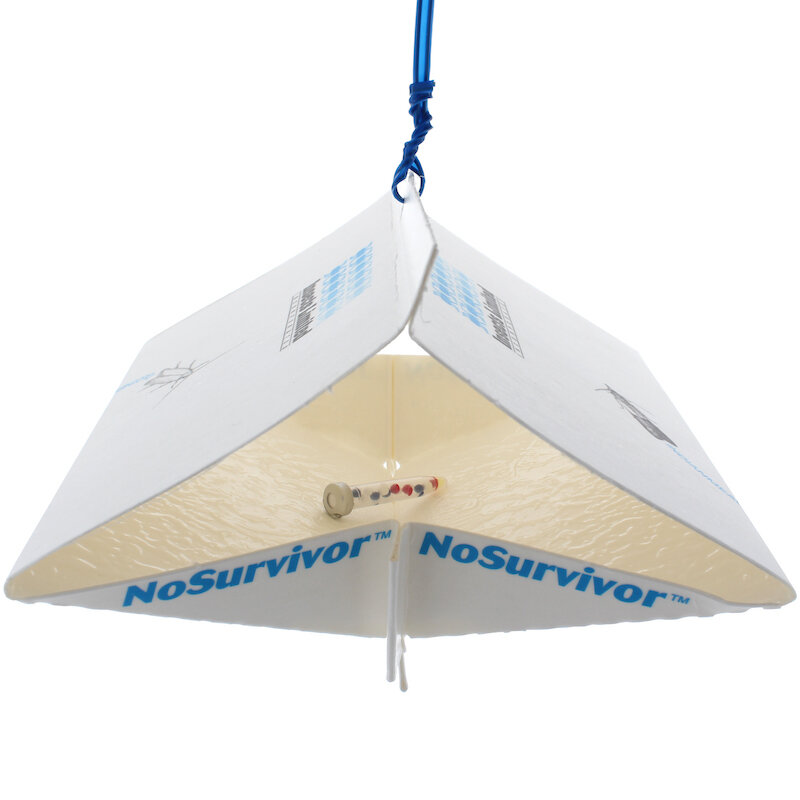Pheromone Traps for Almond Moth
Almond Moth Description
Adults: Up to 13 mm (0.5 inches) long with light grey to tan colored wings. There may be light wavy markings across the wings of this brown moth.
Eggs: Oval, ivory in color and 2 mm (0.08 inches) long.
Larvae: Creamy white, brown head capsule, with rows of spots along the back. Microscopic examination is required to separate from other Ephestia moths.
Pupae: Pupal cases are whitish with a yellow to brownish colored pupa inside.
Almond Moth Life Cycle
Adult moths live for 10-14 days. Mated females can lay 20-120 eggs singly or in groups. Eggs hatch in 3-5 days in warmer months and up to 7 days in cooler months. Larvae mature in 25 days. Development can extend up to 64 days depending on food quality, temperature, and humidity. Larvae will migrate from infested products to pupate. Adults will emerge from pupation in 8 to 10 days depending on temperature.
Damage & Detection
Damage occurs during the larval phase. Granular frass the size of ground pepper can be found in food materials such as nuts, dried fruits, cereals and processed foods containing nuts or seeds and made from wheat, rice, or corn. The use of pheromone traps and inspections can determine location and degree of infestation.
Fun Facts
Commonly confused with Indian meal moths (Plodia interpunctella), Mediterranean flour moth (Ephestia kuehniella), raisin moth (Cadra figulilella) and dried food moth (Cadra calidella).
This species of moth’s scientific name was formerly Ephestia cautella but was changed to Cadra cautella after genetics studies showed that it was not in the Ephestia genus.
Other common names for the Almond moth include tropical warehouse moth, dried currant moth, and fig moth.
Almond moths initiate flight at temperatures above 12.5°C (55°F).
Female and male almond moths initiate courtship behaviors when ready to mate.
The pheromone that attracts Almond moths also attracts over 20 other moth species.
Monitoring Tips & Tricks
Almond Moth Monitoring Guidelines
Lure
BULLET LURE® contains sex pheromone to attract male moths.
Lure Storage
Keep unopened lures in cool storage (less than 60° F) or place in the freezer for extended storage. Lures can remain frozen for up to 24 months to retain their full effectiveness for use afterwards. Shelf life of lures at room temperatures is 12 months.
Trap Designs Used with Lure
NoSurvivor Hanging Traps are diamond shaped sticky traps that can be hung from many locations. This design is the preferred trap for this moth that flies well.
The SightTrap™ can provide daily images and catch data to help with early detection.
Almond Moth Pheromone Traps
Pheromone Trap Placement & Use
Pheromone traps can be placed year-round but are especially recommended when temperatures exceed 12.5°C (55°F). Place hanging pheromone traps 1.5 meters (5 feet) above ground or at eye level to allow for easy inspection when monitoring traps.
Place pheromone traps 7.5 – 15 meters (25 – 50 feet) apart to determine the presence or absence of Almond moths. Increase pheromone trap density to 4.5 – 7.5 meters (15 – 25 feet) apart to help locate the source of Almond moths.
Almond moth pheromone traps are best utilized in areas that store dried goods such as food, grains, seeds, nuts, dried fruit, animal feed, or pet food. Keep pheromone traps 7.5 meters (25 feet) away from exterior doors.
Almond Moth FAQs
What is the almond moth life cycle?
Adult almond moths live for 10-14 days. Mated females can lay 20-120 eggs singly or in groups. Eggs hatch in 3-5 days in warmer months and up to 7 days in cooler months. Larvae mature in 25 days.
Development can extend up to 64 days depending on food quality, temperature, and humidity. Larvae will migrate from infested products to pupate. Adults will emerge from pupation in 8 to 10 days depending on temperature.
What do almond moths look like?
Adult Almond moths are up to 13 mm (0.5 inches) long with light grey to tan colored wings. There may be light wavy markings across the wings. Their eggs are oval in shape and ivory in color and 2 mm (0.08 inches) long.
The eggs are typically too small to see with the naked eye. Larvae are creamy white in color with a brown head capsule and rows of spots along the back. Microscopic examination is required to separate from other Ephestia moths. Pupal cases are whitish with a yellow to brownish colored pupa inside.
How to get rid of almond moths?
The use of pheromone traps, otherwise called pantry moth traps, can indicate the presence of almond moths as well as where the moths are coming from. A visual inspection of dried food in the vicinity of the pheromone traps containing the most moths can reveal specific items containing larvae, pupae, and adult moths.
Once infested materials have been identified, they should be sealed up and discarded into an outdoor trash receptacle or the materials should be sealed in plastic and frozen for a one-week period to kill all stages of the moths.
Join Our Informed Community
Receive the latest industry updates as soon as they are published.





